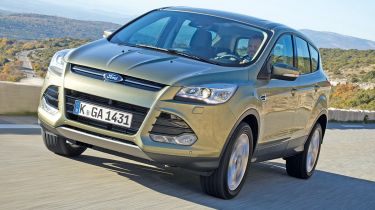Ford Kuga EcoBoost
We’ve already tried the diesel version of the all-new Ford Kuga, so how does the petrol model compare?

This high-powered petrol-engined version of the Kuga is compromised by its six-speed torque converter automatic. As long as you don’t need the extra security that four-wheel drive provides, and don’t mind changing gear yourself, the two-wheel-drive entry-level car is probably a better buy. Its cabin is just as practical, plus it’s well equipped and has a top-value price. Alternatively, the 2.0-litre diesel doesn’t cost too much more, and it’ll be cheaper to run.
Ford predicts that most buyers of the all-new Kuga will go for the 138bhp or 161bhp 2.0-litre diesel models. We drove the latter last year, but a 1.6-litre EcoBoost petrol engine is also available – with far more going for it than the thirsty, dirty 2.5-litre five-cylinder petrol fitted in the old car.
However, the new Kuga’s real headline figure is its price. The front-wheel-drive manual petrol version costs £20,895 – that’s £1,000 less than the previous model. This car is also cheaper, more powerful and cleaner than the new front-wheel-drive Honda CR-V, which comes with a 2.0-litre naturally aspirated petrol engine and six-speed manual gearbox. Our car was the four-wheel-drive 178bhp EcoBoost, which is only available with a torque converter automatic gearbox.
On the move, you immediately realise that 178bhp and 240Nm of torque aren’t quite enough to provide the Kuga with the same nippy performance of the old turbocharged five-cylinder car. Acceleration from 0-62mph takes 9.7 seconds and the engine feels slightly strained all the way around the rev counter.
Used - available now
Even if you’re not chasing 0-62mph times, the auto box always wants to hold on to gears. Under gentle acceleration, it refuses to change up until the upper reaches of the rev range, so you can almost always hear the engine noisily spinning away.
Making matters worse is the fact the box will frequently drop down two gears on motorway inclines, too. This is a real shame because, in terms of road and wind noise, the new Kuga is a big step up from the old car.
It’s very tempting to just pay an extra £750, and get the 161bhp 2.0-litre diesel, which has the same kind of performance, but comes with a much better dual-clutch automatic box, along with far superior fuel economy.
Our 1.6-litre EcoBoost – with its conventional auto and four-wheel-drive system – returns just 36.7mpg and emits 179g/km of CO2. The diesel, on the other hand, achieves a claimed 46mpg.
The petrol model is a little bit lighter than the diesel, but you’ll struggle to notice any real difference in the way it handles.
Disappointingly, the new Kuga isn’t as sharp as its predecessor, which received consistent praise for being one of the best-handling small SUVs.
The design is a little less successful than before, too – thanks in part to Ford’s decision to try to make the Kuga more practical, which has meant squeezing in another 71 litres of boot space and a bit of extra legroom in the back.
The newcomer is very well equipped, though. Our Titanium-spec test car comes fitted with comfortable part-leather seats, climate control and a useful centre armrest incorporated into the back seat, with built-in cup-holders. We’ve no complaints about the smart Focus-inspired dashboard design, either.











